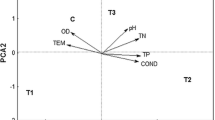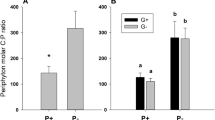Abstract
Stream algal responses to herbivory were investigated under different environmental conditions. Snail densities and nutrient concentrations were manipulated in experimental enclosures to document the influence of nutrient availability on the magnitude of algal responses to herbivory. Periphyton mats in other enclosures were subjected to physical disruption by artificial means to evaluate the influence of disturbance on algal abundance. The impact of herbivory on algal abundance decreased substantially with increase in water column nutrient concentrations. This result was explained by findings that: (1) algal accumulation was constrained by nutrient availability under ambient water quality conditions. (2) accumulation of most algal populations was stimulated by nutrient enrichment only under grazed conditions. Thus, snail grazing simultaneously exerted a negative impact on algal abundance, by removal and consumption of a portion of the periphyton mat, and a stimulative effect, by increasing the availability of nutrients to remaining cells. Algal responses to artificial disturbance indicated that stimulative effects of herbivory were caused by the physical disruption of thr assemblage rather than by other processes (e. g., nutrient regeneration). However, consumptive losses far outweighed stimulative effects on algal abundance under ambient nutrient conditions. The magnitude of these two antagonistic effects was comparable under enriched conditions because grazing had only slight effects on algal abundance. Thus, the importance of different mechanisms of algal-herbivore interactions is strongly influenced by ambient environmental conditions, a finding that has important implications for predicting the outcome of herbivore-algal interactions in ecosystems with pronounced temporal and spatial variation in biotic and abiotic conditions.
Similar content being viewed by others
References
Barnese, L. E., R. L. Lowe & R. D. Hunter, 1990. Comparative grazing efficiency of pulmonate and prosobranch snails. J. N. Am. Benthol. Soc. 9: 35–44.
Colletti, P. J., D. W. Blinn, A. Pickart & V. T. Wagner, 1987. Influence of different densities of the mayfly grazer Heptagenia criddlei on lotic diatom communities. J. N. Am. Benthol. Soc. 6: 270–280.
Cuker, B. E., 1983. Grazing and nutrient interactions in controlling the activity and composition of the epilithic algal community of an arctic lake. Limnol. Oceanogr. 28: 133–141.
Cummins, K. W. & M. J. Klug, 1979. Feeding ecology of stream invertebrates. Annu. Rev. Ecol. Syst. 10: 147–172.
Fairchild, G. W., R. L. Lowe & W. B. Richardson, 1985. Algal periphyton growth on nutrient-diffusing substrates: an in situ bioassay. Ecology 66: 465–472.
Flint, R. W. & C. R. Goldman, 1975. The effects of a benthic grazer on the primary productivity of the littoral zone of Lake Tahoe. Limnol. Oceanogr. 20: 935–944.
Friedl, F. E., 1974. Nitrogen excretion by the freshwater snail Lymnaea stagnalis jugularis Say. Comp. Biochem. Physiol. 49: 617–622.
Gregory, S. V., 1983. Plant-herbivore interactions in streams. In J. R. Barnes & G. W. Minshall (eds), Stream Ecology: Application and Testing of General EcologicalTheory. Plenum Press, New York: 157–189.
Grimm, N. B., 1988. Role of macroinvertebrates in nitrogen dynamics of a desert stream. Ecology 69: 1884–1893.
Hill, W. R., H. L. Boston & A. D. Steinman, 1992. Grazers and nutrients simultaneously limit lotic primary productivity. Can. J. Fish. aquat. Sci. 49: 504–512.
Hoagland, K. D., S. C. Roemer & J. R. Rosowski, 1982. Colonization and community structure of two periphyton assemblages with emphasis on the diatoms (Bacillariophyceae). Am. J. Bot. 69: 188–213.
Hunter, R. D. & W. D. Russell-Hunter, 1983. Bioenergetic and community changes in interdial aufwuchs grazed by Littorina littorea. Ecology 64: 761–769.
Jacoby, J. M., 1987. Alterations in periphyton characteristics due to grazing in a Cascade foothill stream. Freshwat. Biol. 18: 495–508.
Lamberti, G. A., S. V. Gregory, L. R. Ashkenas, A. D. Steinman & C. D. McIntire, 1989. Productive capacity of periphyton as a determinant of plant-herbivore interactions in streams. Ecology 70: 1840–1856.
lamberti, G. A., S. V. Gregory, L. R. Ashkenas, A. D. Steinman & C. D. McIntire, 1989. Productive capacity of periphyton as a determinant of plant-herbivore interactions in streams. Ecology 70: 1840–1856.
Lamberti, G. A., S. V. Gregory, C. P. Hawkins, R. C. Wildman, L. R. Ashkenas & D. M. DeNicola, 1992. Plant-herbivore interactions in streams near Mount St. Helens. Freshwat. Biol. 27: 237–247.
Lamberti, G. A. & V. H. Resh, 1983. Stream periphyton and insect herbivores: an experimental study of grazing by a caddisfly population. Ecology 64: 1124–1135.
Lock, M. A., R. R. Wallace, J. W. Costerton, R. M. Ventullo & S. G. Charlton, 1984. River epilithon: toward a structural-functional model. Oikos 42: 10–22.
Mayer, M. S. & G. E. Likens, 1987. The importance of algae in a shaded headwater stream as food for an abundant caddisfly (Trichoptera). J. N. Am. Benthol. Soc. 6: 262–269.
McCormick, P. V., 1991. Lotic protistan herbivore selectivity and its potential impact on benthic algal assemblages. J. N. Am. Benthol. Soc. 10: 238–250.
McCormick, P. V. & R. J. Stevenson, 1989. Effects of snail grazing on benthic algal community structure in different nutrient environments. J. N. Am. Benthol. Soc. 8: 162–172.
McCormick, P. V. & R. J. Stevenson, 1991. Grazer control of nutrient availability in the periphyton. Oecologia 86: 287–291.
Meulmans, J. T., 1987. A method for measuring selective light attenuation within a periphytic community. Arch. Hydrobiol. 109: 139–145.
Minshall, G. W., 1978. Autotrophy in stream ecosystems. Bioscience 28: 767–770.
Mulholland, P. J., A. D. Steinman, A. V. Palumbo & J. W. Elwood, 1991. Role of nutrient cycling and herbivory in regulating periphyton communities in laboratory streams. Ecology 72: 966–982.
Nicotri, M. E., 1977. Grazing effects of four marine intertidal herbivores on the microflora. Ecology 58: 1020–1032.
Patrick, R., 1970. Benthic stream communities. Am. Sci. 58: 546–549.
Peterson, C. G., 1987. Gut passage and insect grazer selectivity of lotic diatoms. Freshwat. Biol. 18: 455–460.
Power, M. E., A. J. Stewart & W. J. Matthews, 1988. Grazer control of algae in an Ozark Mountain stream: effects of short-term exclusion. Ecology 69: 1894–1898.
Pratt, J. R. & J. Cairns, Jr., 1985. Functional groups in the protozoa: roles in differing ecosystems. J. Protozool. 32: 415–423.
Pringle, C. M., 1985. Effects of chironomid (Insecta: Diptera) tube-building activities on stream diatom communities. J. Phycol. 21: 185–194.
Riber, H. H. & R. G. Wetzel, 1987. Boundary-layer and internal diffusion effects on phosphorus fluxes in lake periphyton. Limnol. Oceanogr. 32: 1181–1194.
SAS Institute, 1985. SAS user’s guide: statistics, v.5. SAS Institute, Cary, NC., 956 pp.
Sokal, R. R. & F. J. Rohlf, 1981. Biometry, 2nd ed. W. H. Freeman and Co., New York, 859 pp.
Steinman, A. D., 1992. Does an increase in irradiance influence periphyton in a heavily-grazed woodland stream?.Oecologia 91: 163–170.
Swamikannu, X. & K. D. Hoagland, 1989. Effect of snail grazing on the diversity and structure of a freshwater attached algal community. Can. J. Fish. aquat. Sci. 46: 1698–1704.
Welsch, R. E., 1977. Stepwise multiple comparison procedures. J. Am. Stat. Ass. 72: 359–365.
Author information
Authors and Affiliations
Rights and permissions
About this article
Cite this article
McCormick, P.V. Evaluating the multiple mechanisms underlying herbivore-algal interactions in streams. Hydrobiologia 291, 47–59 (1994). https://doi.org/10.1007/BF00024238
Received:
Accepted:
Issue Date:
DOI: https://doi.org/10.1007/BF00024238




